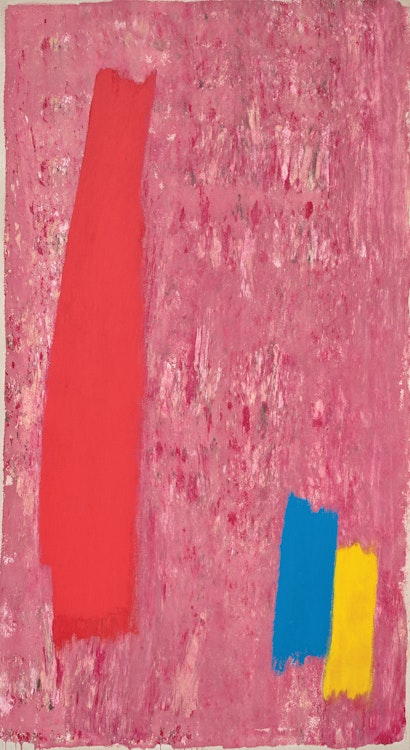Vic Day, 1974 by Jack Hamilton Bush

Jack Bush
Vic Day, 1974
acrylic on canvas
signed, titled, dated “May 1974 Toronto” and inscribed “acrylic polymer W.B.” on the reverse; catalogue raisonné no. 3.7.1974.28
67.5 x 37 in ( 171.5 x 94 cm )
Auction Estimate: $125,000.00 - $175,000.00
Price Realized $156,000.00
Sale date: May 28th 2025
The Artist, May 1974
David Mirvish Gallery, Toronto, March 1975
Ken Carpenter, Toronto
By descent to the present Private Collection, Toronto
Ken Carpenter, 'The Evolution of Jack Bush', "Journal of Canadian Art History IV: 2", 1977-1978, figure 10, pages 127-128
'The Inspiration of Jack Bush', "Art International XXI", no. 4 (July/August 1977), pages 25-26
Sarah Stanners, "Jack Bush Paintings: A Catalogue Raisonné, Volume 4: 1972-1977", Toronto, 2024, reproduced pages 244-245, no. 3.7.1974.28
In conversation with Terry Bush, the artist’s youngest son, I came to better understand a short series of paintings from the spring of 1974 with titles such as "Twosome" and "Foursome" which, like "Vic Day", present distinct, flatly-coloured shapes against a mottled ground produced with a roller brush. In the case of "Twosome", the shapes look like the letters “G” and “L” which represent the artist’s friends Leslie and Gladys Wookey. In "Foursome", two more figures enter the picture space, this time one is noticeably larger than the others, and pink, and the other is yellow. These two simpler shapes, which represent Mabel and Jack, join the reappearing “G” and “L” on this canvas, to unite the friend group. Seen in this light, the artist’s seemingly random shapes take on some personality. Could the shapes in "Vic Day" represent the artist and the people with whom he spent the holiday? "Foursome" was painted in March 1974, just two months before "Vic Day", and they share the same tall shape near to a short yellow shape. Could they be abstract symbols of Jack and Mabel? In any case, that is, despite not knowing for sure if these shapes might represent the people in his life, quirky cyphers have always been viewed as markers of the artist’s brilliant individuality.
Professor Ken Carpenter, who proudly owned "Vic Day" since 1975, saw the individuality of Bush’s work as an asset. In his article for "Art International", titled “The Inspiration of Jack Bush”, published in the summer of 1977, Carpenter underlined this point with reference to an interview he had previously conducted with the artist:
“Bush’s work always seems very personal, very much the work of Jack Bush. But that result was not something he explicitly intended: ‘Every time I showed a painting at one of those [group] shows, there it was: not like everybody else’s. The difference was Bush, and I couldn’t get rid of it fortunately’.”
Other art critics and curators, such as Terry Fenton and Karen Wilkin, frequently used the term “eccentric” to describe Bush’s abstract paintings. While the hints of nature (or the observable world) in Bush’s abstract paintings made him appear somewhat out of sync with concepts of “purely” abstract painting, this characteristic was also his best quality, and one that was consistently seen throughout his oeuvre, but not in a practiced or formulaic way. As Carpenter stated, so succinctly, “One of the most important constants of Bush’s art is the tendency for the elements to have a life and freedom of their own.” Carpenter made this observation in another feature article on the artist, which he titled "The Evolution of Jack Bush," and published in the "Journal of Canadian Art History", just a few months after his "Art International" article, which I quoted earlier in this essay. Carpenter outlines the connections between Jack Bush’s early representational art and his later abstract paintings, to suggest that there is an evolution observable in the artist’s work. For example, he correlates Bush’s 1955 painting "Reflection", which features a blurry section achieved through dragged brushstrokes, with the roller ground seen in "Vic Day".
Being careful not to suggest that Bush expressed himself exclusively within his own off-beat language of art, Carpenter does outline the wider influence on the artist, especially concerning his blurred backgrounds, as seen in "Vic Day". The key inspiration in this case is Hans Hofmann, who Jack Bush certainly admired; he even owned a painting by this father of Color Field art. Carpenter draws the comparison between "Vic Day" and a Hofmann painting from 1962, "Memoria in Aeternum", in the collection of the Museum of Modern Art in New York:
“More particularly the importance of Hofmann lies in his fine sense of interval. If we compare Bush’s "Vic Day" 1974 with Hofmann’s "Memoria in Aeterne" [sic] 1962, we see that each has a rich complex of intervals: between the canvas itself and the field, between the field and the elements, and between the various elements themselves, where each of the intervals is felt and yet not to be defined. Everything breathes in a space that seems to exist in front of the canvas but without any part of the picture losing its organic contact with the surface.”
Much of the power of Bush’s late abstract paintings lies in what Carpenter points to in this last sentence. Simply put, there is levity in an implied space (between the figure and the ground) which is actually flat as flat can be. But there is also nature in that space. In his summary paragraphs to “The Evolution of Jack Bush,” Carpenter noted: “While Bush remained close to nature, his chosen mode of mature work was high ‘modernist’ painting with all its rejection of the fullness and consistency of spatial clues such as are in keeping with a tactile or more naturalistic space.” That Bush struck a balance between observation and the pure invention of abstraction is remarkable, and "Vic Day" is a fine celebration of this feat.
We extend our thanks to Dr. Sarah Stanners, an Adjunct Professor, curator, and author who recently produced Jack Bush Paintings: A Catalogue Raisonné (2024), for contributing the preceding essay.
Share this item with your friends
Jack Hamilton Bush
(1909 - 1977) Painters Eleven, Canadian Group of Painters, OSA, ARCA
A founding member of the Painters Eleven group and the subject of major retrospectives at the Art Gallery of Ontario (1976) and the National Gallery of Canada (2014), Jack Bush (born March 20, 1909 in Toronto; died January 24, 1977 in Toronto) was one of Canada’s most influential artists. Among the first Canadian painters of his generation to achieve international success in his lifetime, Bush was a masterful draftsman and colourist whose works are coveted by major institutions and private collectors throughout the world. Born in the Beaches neighbourhood of Toronto in 1909, Bush spent his childhood in London, Ontario, and Montréal, Québec, where he studied at the Royal Canadian Academy and apprenticed as a commercial artist in his father’s business, Rapid Electro Type Company. After relocating in 1928 to work in the firm’s Toronto offices, his interest in fine art grew through contact with members of the Group of Seven, the Ontario Society of Artists, and the Canadian Group of Painters. Working as a commercial artist by day, Bush painted and took night classes at the Ontario College of Art (now the Ontario College of Art and Design University) throughout the 1930s, studying under Frederick Challener, John Alfsen, George Pepper, J. E. H. MacDonald, and Charles Comfort. After forming the commercial design firm Wookey, Bush and Winter in 1942 with partners Leslie Wookey and William Winter, Bush remained engaged in the graphic art world until his retirement in 1968.
Like many of his contemporaries in Toronto, Bush had little exposure to international trends of modernism during his formative years as a painter. For nearly two decades, he drew inspiration for his landscape and figural paintings from works by members of the Ontario Society of Artists and the Canadian Group of Painters. Though he began to incorporate non-representational elements in his work in the late 1940s, Bush’s more focused experimentations with formal abstraction in the early 1950s reveal the conspicuous influence of his eventual encounters with modern artwork in Toronto and New York City. In 1953, Bush joined the newly-founded Toronto artist group Painters Eleven. Through his involvement in the group’s efforts to promote abstract painting in Canada, Bush met the influential New York City art critic Clement Greenberg. Their resulting friendship would influence Bush’s early development as an abstract painter, with Greenberg serving as an occasional mentor to the artist, encouraging him to abandon his Abstract Expressionist style in favour of a brighter, more refined palette and technique. Through his association with Painters Eleven, Bush became closely tied to Colour Field painting and Lyrical Abstraction—two movements that had evolved from Abstract Expressionism. After the group disbanded in 1959, Bush’s distinguished career was marked by numerous achievements, including the opportunity to represent Canada at the São Paulo Art Biennial in 1967, after which his art found considerable commercial success in the United States (Bush had already been showing his work in New York City since 1962). In 1963, Hugo McPherson in his review of Bush’s showing at the Gallery Moos, Toronto, linked Bush with Matisse as follows, “...he reminds us of the classical joy and simplicity of the later Matisse. This is his richest vein. His comments on France, Italy, and Spain, and his observations titled ‘Red on Pink’ and ‘Growing Plant’ are at once spare and bright and probing.”
In 1972, Bush was the subject of the inaugural survey exhibition in the modern wing of the Boston Museum of Fine Arts. Four years later, the Art Gallery of Ontario organized a major touring retrospective of his work. Bush as a member of the Canadian Society of Painters in Water Colour, 1942 (former President); Ontario Society of Artists (former Vice-President) 1943; Associate Royal Canadian Academician, 1946; Canadian Group of Painters’, 1948, and the Art Directors’ Club of Toronto. In 2014, the National Gallery of Canada hosted a major retrospective exhibition of Jack Bush’s work. A comprehensive catalogue raisonné of Bush’s work is set to be released in the coming years.
Jack Bush died at the age of 68 in 1977, one year after he received the honour of Officer of the Order of Canada.

